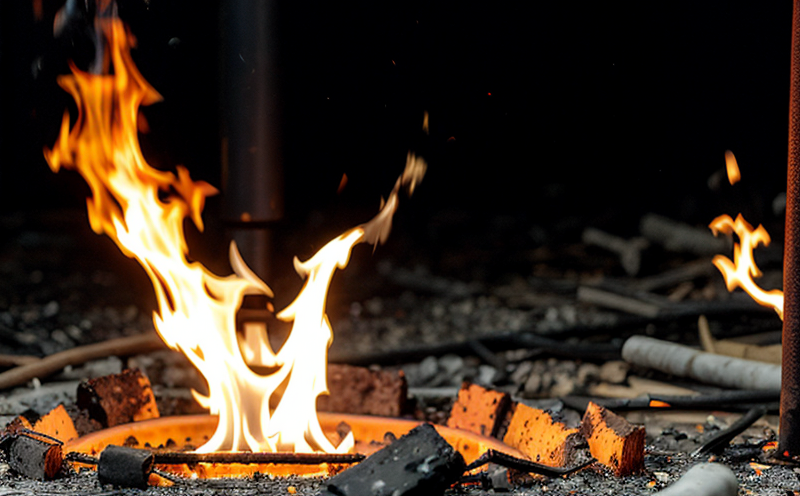ASTM F963 Spark-Emitting Toy Fire Hazard Testing
The ASTM F963-17 standard sets forth the requirements, test methods, specifications, and guides for consumer products that are intended to be used by children under 14 years of age. Within this comprehensive document, specific sections address fire hazard concerns related to toys, ensuring they meet stringent safety standards.
One critical aspect is testing for spark-emitting toy hazards, which can pose significant risks if not properly addressed. ASTM F963-17 specifies that certain types of materials and designs on toys may emit sparks under specified conditions. These sparks could ignite nearby flammable substances or cause direct burns to children, making this testing essential.
Flammability tests for spark-emitting toys are particularly challenging because they require specialized equipment capable of simulating real-world scenarios where the toy might come into contact with ignition sources. This includes not only open flames but also static electricity and other potential ignition points. The primary goal is to identify any materials or components that could contribute to a fire hazard.
During testing, toys are subjected to controlled environments designed to mimic various environmental conditions encountered during playtime. For instance, some tests involve placing the toy near an open flame for extended periods while others examine how static electricity interacts with different parts of the toy. The focus is on identifying any areas where sparks might be generated and assessing whether these sparks could ignite surrounding materials or cause burns.
Once initial screenings have been conducted, further detailed analysis may follow using advanced analytical techniques such as thermogravimetric analysis (TGA), differential scanning calorimetry (DSC), or Fourier transform infrared spectroscopy (FTIR). These methods help determine the exact composition of materials involved in spark generation and assess their flammability potential more precisely.
Another important consideration during ASTM F963 spark-emitting toy fire hazard testing is ensuring that all components adhere to both national regulations like those found within ASTM standards as well as international guidelines such as ISO or EN specifications. Compliance with these standards ensures consistency across various markets and helps manufacturers comply with global safety requirements.
It's crucial for quality managers, compliance officers, R&D engineers, and procurement professionals involved in toy development to understand the complexities surrounding spark-emitting fire hazards. By adhering strictly to ASTM F963-17 guidelines throughout product design stages, companies can significantly reduce the risk of recalls due to safety issues while enhancing overall consumer confidence.
Scope and Methodology
The scope of ASTM F963 spark-emitting toy fire hazard testing encompasses a variety of materials used in manufacturing children's toys. This includes plastics, textiles, metal components, coatings, and any other elements that could potentially emit sparks when subjected to certain conditions.
Testing methodologies vary depending on the type of material being evaluated but generally follow these steps:
- Initial Screening: Conduct preliminary tests to identify materials or parts likely to generate sparks.
- Controlled Environment Testing: Subject toys and their components to controlled environments that simulate typical play scenarios. This could involve placing the toy near an open flame, exposing it to static electricity, or other relevant conditions.
- Data Collection: Record all observed sparks and measure their intensity and duration.
- Analytical Analysis: Use advanced analytical techniques like TGA, DSC, FTIR, etc., to determine the composition of materials involved in spark generation.
The methodology aims at providing detailed information about each material's flammability potential and its contribution towards creating a fire hazard. This approach ensures that all components meet strict safety standards outlined by ASTM F963-17.
Quality and Reliability Assurance
Ensuring the quality and reliability of ASTM F963 spark-emitting toy fire hazard tests is paramount to maintaining consumer trust. At our laboratory, we employ a rigorous quality assurance process that includes:
- Certified Personnel: Our team consists of highly trained experts who are certified according to relevant industry standards.
- State-of-the-Art Equipment: We utilize cutting-edge instrumentation and facilities capable of replicating real-world conditions accurately.
- Standard Operating Procedures (SOPs): All tests adhere strictly to ASTM F963-17 guidelines, ensuring consistency across all evaluations.
- Continuous Improvement: Regular training sessions and updates ensure our team stays current with evolving standards and best practices.
We also maintain strict confidentiality agreements to protect proprietary information. Our commitment to excellence guarantees accurate, reliable results that meet or exceed regulatory requirements.
Use Cases and Application Examples
The ASTM F963 spark-emitting toy fire hazard testing is particularly relevant for manufacturers producing electronic toys, remote-controlled vehicles, or any other items containing batteries or electrical circuits. These products are more susceptible to generating sparks due to their inherent components.
For instance, a manufacturer of robotic teddy bears might want to ensure that the internal motors and battery connections do not pose fire hazards when activated by children. Similarly, companies developing smart toys with Wi-Fi capabilities need assurance that all wireless components comply with safety regulations.
In another scenario, if a toy company introduces new materials in their products, such as recycled plastics or innovative coatings, they would benefit from ASTM F963 testing to verify the flammability properties of these materials before launching them into production. This ensures that no newly introduced component poses a risk during playtime.
Additionally, regulatory bodies responsible for enforcing toy safety laws often request independent third-party labs like ours to perform these tests on behalf of manufacturers. By providing comprehensive reports detailing the results of ASTM F963 spark-emitting fire hazard testing, we help ensure compliance with international standards and protect public health.





